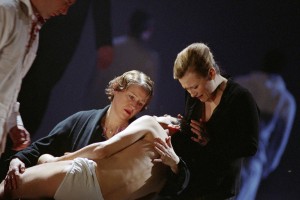ENO
21st January 2005
 ENO is building a very solid base for the presentation of oratorio. After challenging - and musically satisfying -performances of Bach's St John Passion and the Verdi Requiem comes Tippett's A Child of Our Time. While there may be a connection with the later events of the Second World War the touchstone for the work was the Nazi reaction to the shooting of a Parisian diplomat by a Polish Jew - who ironically seems to have survived the war, unlike so many of his compatriots.
ENO is building a very solid base for the presentation of oratorio. After challenging - and musically satisfying -performances of Bach's St John Passion and the Verdi Requiem comes Tippett's A Child of Our Time. While there may be a connection with the later events of the Second World War the touchstone for the work was the Nazi reaction to the shooting of a Parisian diplomat by a Polish Jew - who ironically seems to have survived the war, unlike so many of his compatriots.
But Tippett deliberately sets out to avoid any particular context for the action of the piece - if there can be said to be any action. Soloists and chorus change characters as the narrative unfolds and, like Messiah, the opening and closing sections are essentially meditations on the pain and destructive power of war and its associated violence to whole societies, not just to combatants.
All of this is musically framed by Tippett's use of Negro Spirituals which act as points of hope within a hopeless world. Jonathan Kent directs the stage presentation with both simplicity and nobility. Possibly to avoid excess costs the action takes place within a vast black void, almost as large as I can recall the Coliseum stage being used since its revamp, and everyone on stage is in black. With the highly sensitive lighting of Mark Henderson individuals drift in and out of focus, often disappearing altogether, as if they are suddenly of no consequence. The four soloists bring authority to the narrative without ever cutting themselves off from the ever present chorus who are equally individualised. Key moments stay in the memory. Light oozes in from the back only to be snuffed out again, stone kerns are piled up, weapons give way to lights. Most impressively, the small tree which emerges from the dead boy suddenly burst into flame - becoming both burning bush and winter fire. Tippett would surely have relished the imagery!
Susan Gritton, Sara Fulgoni, Timothy Robinson and Brindley Sherratt are all ENO regulars but none the less welcome in this densely focussed presentation - with Susan Gritton effortlessly riding the choral sound even at its fullest. The chorus were superb - better than in either of the other two oratorios - and thrillingly dynamic in the spirituals. Martyn Brabbins produced some of the most effective orchestral sounds this season.
There is one more performance on 28 January. Surely a work of this impact deserves more performances than this? Revive soon!
BH
